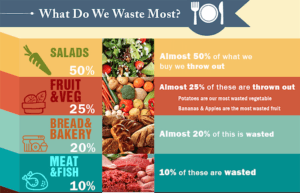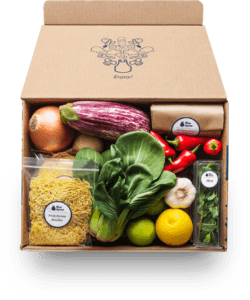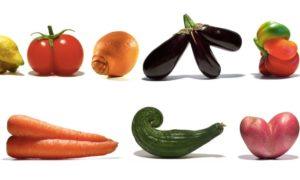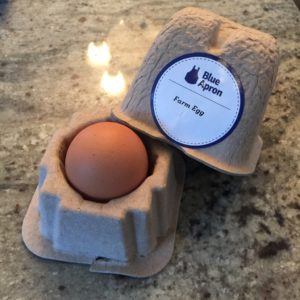Waste in Agricultural Supply Chains: Is Meal-Kit Delivery the Solution?

In the face of climate change and consequential increased consumer focus on sustainability, meal-kit delivery startup, Blue Apron, is focused on fighting food waste, but can the company do more to gain an advantage over competitors?
Agriculture and Climate Change: A Vicious Cycle
The agricultural industry is one of the largest consumers of earth’s limited resources. In the United States, the production, transportation, and distribution of food utilizes 10% of the country’s energy, consumes 80% of freshwater, and uses 50% of land.[1] However, due to significant wastage at every step from farm to table, much of the resource consumption is fruitless—approximately 30-40% of the food supply in the U.S. is wasted, highlighting gaping inefficiencies in the agricultural supply chain.[2]
These inefficiencies will be exacerbated as a result of continued trends requiring increased food production: climate change, spurring less predictable and lower yielding harvests due to droughts and floods; population growth, resulting in more mouths to feed; and rising income levels, which is likely to lead to an increase in consumption of meat, a product particularly taxing on resources.
Additionally, there is a vicious cycle by which food waste—the largest single category in landfills, comprising nearly 22% of municipal solid waste—contributes significantly to methane emissions, and consequently climate change, as it decomposes and the nutrients are unable to return to the soil.[3]
Meal-kit delivery service, Blue Apron, claims that its business, which provides customers a prepackaged box with a recipe and just enough food to cook it, helps to eliminate food waste. With consumers increasingly aware of the damaging environmental effects of agriculture and a heightened focused on sustainability, it is critical that Blue Apron continue to innovate to prove its benefits relative to traditional grocery stores and to meal-kit competitors.
Blue Apron’s Existing Sustainability Measures
One of the key selling points of meal-kit delivery services is the assertion that they help to minimize food waste in the home. By providing exactly the right portions of ingredients to complete recipes, consumers do not accidentally over purchase at the grocery store nor do they end up throwing away produce that rots before they have the chance to eat it.
As a competitive advantage on the operations side, Blue Apron has implemented a number of specific processes that help to limit waste. First, in order to more precisely and effectively purchase its own ingredient supply, Blue Apron tries to forecast customer demand and buy only what is needed to fulfill it. Additionally, the company closely tracks its produce supply chain, projecting availability on its partner farms up to three years in the future. Undertaking these measures in close coordination with farmers allows for more reliable meal planning for Blue Apron and, subsequently, helpful crop planning for partner farmers.[4] Blue Apron’s Director of Communication, Nisha Devarajan, has explained: “Providing a source of predictable demand for these farms allows them to net a better yield and produce what’s most effective on their land.”[5]
Blue Apron has described additional initiatives it will undertake in the short- to medium-term in order to further cut food waste, including continuing to improve demand forecasting tools and using innovative automated equipment to more efficiently and less wastefully prepare ingredients for shipment.[6]
What else can Blue Apron do?
An independent report commissioned by Blue Apron estimates that the meal-kit delivery startup reduces food waste in landfills by 62% relative to grocery stores.[7] However, there is more that Blue Apron can do.
Today, approximately 20% of produce never leaves the farm because it is too aesthetically imperfect to be accepted by grocery stores or other retailers.[8] Blue Apron could launch an initiative to include these misfit fruits and vegetables in their meal kits. In this way, the company would not only contribute to limiting food waste within homes but could make a significant impact on waste at farms as well. Consumers could opt-in to the program and potentially get a discount on the meal kit for doing so, as Blue Apron is likely to be able to purchase imperfect produce at a discount from farmers.
Blue Apron could also consider tailoring menus regionally depending on what is available for purchase at supplier farms near each of the company’s distribution centers. This will help ensure more secure demand for farmers, further reducing waste on farms and building stronger relationships with farmers, which may lead to cost savings at Blue Apron.
Despite its progress in fighting food waste, Blue Apron’s supply chain wears on the environment in other ways. How harmful is the transportation/refrigeration of ingredients, packaging of meals, and distribution of kits? Can the company do more to support recycling/upcycling, particularly of non-recyclable materials, such as freezer packs?
[Word count: 786]
[1] Gunders, Dana. 2012. “Wasted: How America Is Losing Up To 40 Percent Of Its Food From Farm To Fork To Landfill”. National Resource Defense Council: Issue Paper, no. 12-06B. https://www.nrdc.org/sites/default/files/wasted-food-IP.pdf.
[2] “U.S. Food Waste Challenge”. 2016. United States Department of Agriculture. https://www.usda.gov/oce/foodwaste/faqs.htm.
[3] “Sustainable Management of Food Basics”. 2015. United States Environmental Protection Agency. https://www.epa.gov/sustainable-management-food/sustainable-management-food-basics.
[4] Barth, Brian. “Meal-Kit Mania Unpacked”. November 2016. Modern Farmer. https://modernfarmer.com/2016/11/meal-kit-blue-apron-meal-delivery-service/.
[5] Kroll, Karen M. “Meal Delivery Services: You’ve Got to be Kitting Me!”. August 2016. Inbound Logistics. http://www.inboundlogistics.com/cms/article/meal-delivery-services-youve-got-to-be-kitting-me/.
[6] Peters, Adele. “Cooking With a Meal Kit May Waste 62% Less Food Than Grocery Store Ingredients”. September 2016. Fast Company. https://www.fastcompany.com/3063772/cooking-with-a-meal-kit-may-waste-62-less-food-than-grocery-store-ingredients.
[7] Ibid
[8] Quittner, Ella. “Imperfect Produce: A Rescue Mission to Combat Food Waste”. August 2017. Gardenista. https://www.gardenista.com/posts/imperfect-produce-a-rescue-mission-to-combat-food-waste/.







An excellent article highlighting a critical issue in all OECD countries around the world. Blue Apron is a start and the imperfect produce initiative has been wildly successful in Australian supermarkets since deployment of cut price “odd bunch” produce across the nation but with the rise of restaurants, busy people and food delivery it would be interesting to know the waste statistics for restaurants and fast food.
Arguably, these businesses have a strong role to play in the reduction of waste, even lobbying for changed food hygiene standards to allow produce to be re-used or sold at a reduced price rather than wasted.
Is this an easier place to start than with individual households and can this be a starting pad for regulators to show some real endeavor on this topic instead of leaving it to startups such as Blue Apron?
To your question above regarding the harm caused by ‘transportation/refrigeration of ingredients, packaging of meals, and distribution of kits’, I would argue that the Blue Apron model already performs better on these dimensions than our typical supply chain. The crux of the improvement is in that Blue Apron is not buying from grocery stores like you and me- they are going direct to farmers and cutting out a massive ecosystem of wholesalers, distributors and retailers that sit in between- each of which are associated with their own transportation, refrigeration and packaging systems. These are costs that we the consumer do not see, so when our Blue Apron boxes come, seemingly with each individual grain of salt in it’s own personal plastic bag, it feels like a massive waste to us, but compared to the entire ecosystem of storage, preservation and delivery sitting behind our traditional grocery stores, this impact is actually quite minimal.
See below for more discussion of this concept:
https://www.eater.com/2015/6/26/8839791/blue-apron-review-pros-cons-environment
https://www.blueapron.com/pages/vision (#3)
Interesting article!
I disagree with CL’s comment above: Blue Apron’s supply chain does have a significant negative impact on the environment.
(1) Transportation/refrigeration of ingredients and distribution of kits: while it is true that Blue Apron purchases supplies directly from farms (in fact, it sources its ingredients from 100 different family-run farms), it delivers to most of country from 3 distribution centers nationwide. This means that, before you receive a Blue Apron box, it probably crossed a good part of the United States in a refrigerated truck.
(2) Packaging of meals: after cooking a Blue Apron meal, you are stuck with a ton of waste which is not as easily recyclable as one would hope.
Some interesting articles on the topic, with more details on (1) and (2): https://www.buzzfeed.com/ellencushing/these-are-the-trashy-consequences-of-blue-apron-delivery?utm_term=.tcjGBQkqP#.pqPVnkmOd, http://observer.com/2017/04/packaging-waste-blue-apron-meal-kits/
I really buy into the idea that meal kits like Blue Apron are a great way to reduce food waste in the agricultural supply chain. The newly formed Business Ideas for Generational Shifts club at HBS recently had a discussion on the inefficiencies of the legacy grocery shopping experience. For working professionals, buying groceries in large quantities, such as a gallon of milk or a pound of salmon, is wasteful because a working professional can’t consume all the produce before it expires. Meal kits are a great way to solve this problem by controlling for portion sizes.
One paradox I see with the Blue Apron business model is that it’s a subscription service with relatively moderate minimum delivery volumes. A customer is required to order at least three 2-person meals each week. For a single working professional, this is probably too much food, and even for a dual income, no kids household, work trips and last-minute evening events could result in meal kits not being used, which leads them to be wasted. To truly embrace waste minimization, Blue Apron should offer more flexibility in delivery cadences for its customer. It’s interesting to note that Blue Apron’s customer retention has been low: an estimated 72% of customers churn within six months. More flexibility would likely also help with customer retention. This can also lower the impact of transportation and refrigeration.
Another interesting move would be to acquire Imperfect Produce, vertically integrating them into the supply chain. Blue Apron would also be able to expand its product offerings by selling the imperfect produce directly to customers. This would give Imperfect Produce a much broader reach, as Blue Apron has a more expansive distribution network.
Pricing: https://www.blueapron.com/pages/pricing
Retention issues: http://www.slate.com/blogs/business_insider/2017/06/30/blue_apron_customer_retention_low.html
Blue Apron’s model is certainly interesting–minimize food waste by shipping exact ingredients, but potentially add to climate issues with its intensive packing and transportation methods.
On food waste, I think it is a great idea to ship only what is necessary–I have found that especially living alone, I always buy more groceries than I actually consume and will need to throw many of my perishables out at the end of the week. The idea of only getting what you need not only minimizes waste but creates a consumer reliance on Blue Apron to supply all ingredients. With Blue Apron, consumers will not be incentivized to stock up on anything (since they will send you even packets of salt), and trips to grocery stores for a handful of items will be less worthwhile. For “misfit” veggies that are not physically appealing for grocery store displays, Blue Apron should potentially try to pre-cut/ prepare the items for the meal kits to minimize customer perceptions that the supplies provided in the meal kits are any less fresh than those purchased in grocery stores.
I am, however, concerned at the impact of packaging two-meal portions of ingredients such as spices. There are certainly some items that I think Blue Apron can assume customers have to minimize unnecessary and wasteful packaging. For instance, baking kits that offer the powder to produce cakes will generally assume that the consumer has their own stock of eggs, water and milk to mix with the powder, and does not include that in the product itself. Blue Apron can definitely move more towards this direction to assume that the average consumer will have a pantry of general ingredients, without sacrificing much of its value to the customer.
Thanks for the excellent article. I want to respond to the author’s concern about recyclability of the packaging materials. A potential solution could be to have a free return policy for some of the materials that might be impossible to recycle, such as ice packs, bubble wraps, some of the ingredient bags, and possibly the box. Not only will doing this reduce the issue with some of the environmental issues raised by critics, but it would be a great cost savings benefit. If enough of these packaging materials are returned, the company should be able to break even on its recycle program
I agree with the discussion above that while Blue Apron is helping reduce food waste through individual size meal kits, its packaging, cold storage and transportation is increasing waste. On the packaging front, I think there is more that Blue Apron can do to reduce waste and one-time use packaging options while not compromising on the customer experience – given that consumers need to opt for 2-3 meals / week that at the moment are delivered on 2-3 separate nights of the week, Blue Apron could use an Amazon Fresh type of cold storage reusable bag that has all the ingredients for the week in one bag, thereby reducing the total number of plastic and cardboard storage containers. Furthermore, consumers can return this bag to Blue Apron the same way that consumers currently return Amazon Fresh bags. Another option is to reward consumers for recycling (e.g., can deduct $ from overall cost of the meal kit if they send back the plastic and cardboard containers) so that Blue Apron can directly manage the recycling process.
My biggest question after reading this is on scale of impact. While I really appreciate when company’s can point to specific reductions in emissions/other improvements from their supply chain or products, I’m not really sure it moves the needle on a global scale. I think it will take international legislation and pollution targets to really drive change. Therefore, I think companies can be most effective causing meaningful change through example.
On this metric, I think Blue Apron has potential. If its business model serves as a spotlight to the level of waste in traditional food supermarkets and normal customer use, then I think that’s excellent. They could serve at a catalyst for real change in the way consumers eat and (not) waste food. However, if the main takeaway industry observers and customers take away is that delivery is the most convenient – then that might send a counterproductive message of using more wasteful packaging etc. I think this level of impact comes down to the company’s marketing and PR messaging as much actual waste reduction performance. Otherwise, the impact of the change will only be as large as the amount of customers that the company actually serves.
In terms of packaging materials, besides options already mentioned above (reusable/returnable options), Blue Apron can work on reducing quantity. Green Chef, a competitor, featured an article on Fortune on the topic (http://fortune.com/2017/04/20/green-chef-sustainable-packaging/), with reduced pounds of ice that free up more space in trucks, decreasing packaging costs and improving transportation efficiency.
Another way to reduce the impact of refrigeration along the entire chain is to have/incentivize “communal refrigerators” with controlled access / retrieval located in key spots around the city (particularly in condos and high-traffic pedestrian areas, such as metro stations). It would be like a “vending machine meal kit pickup”. Assuming Blue Apron has enough volume, those “communal refrigerators” would be part of their marketing strategy and could eliminate the need of having refrigerators running on each and every household, reducing overall energy consumption associated with wasted “refrigeration” in sub-utilized refrigerators that sit (almost) empty for the majority of its time.
The statistics on food wastage and the amount of fresh water (+ other resources) going into food production are shocking to me. I agree with Worried Sommelier’s concerns about scale of impact. Scale is a huge issue for a lot of startups in the food space, as the market is so large that moving the needle will be a difficult feat. We’ve seen this with Impossible Foods, a fake meat company (beef production is one of the most energy and land intensive processes in the food production chain, using 10x more land than vegetable end products). Blue Apron shipped 8M monthly meals in 2016 (http://fortune.com/2017/04/11/blue-apron-sales/), while the US market is 29 bn monthly meals. The meal delivery kit appeals to a particular demographic (busy, urban, higher willingness to pay), more mainstream than an Impossible Foods burger consumer but probably not so different. These two companies and small scale of their operations lead me to believe that for real change to occur, a shock will have to take place (for example, a big increase in the price of beef).